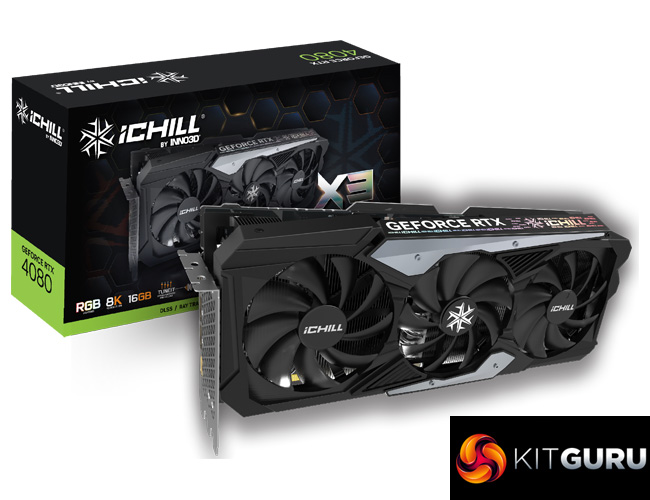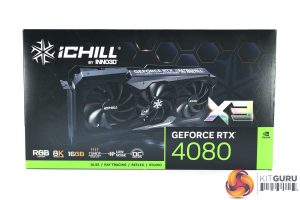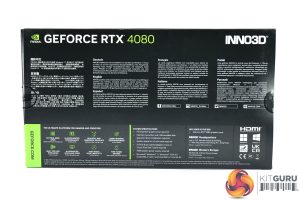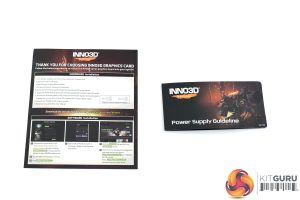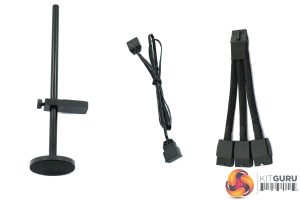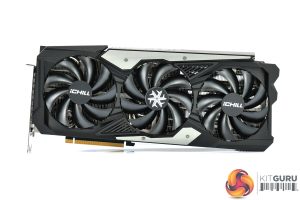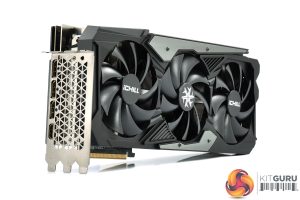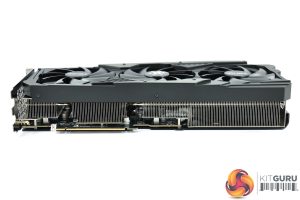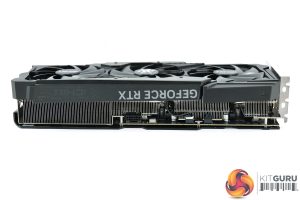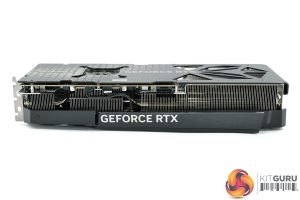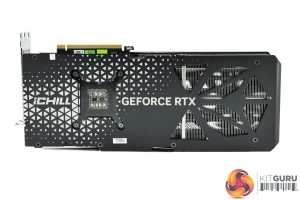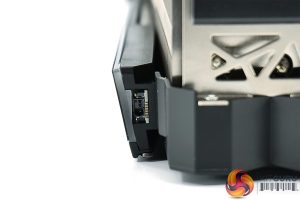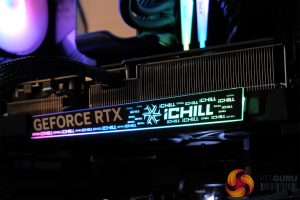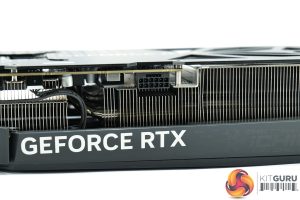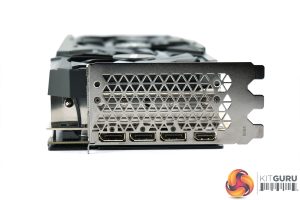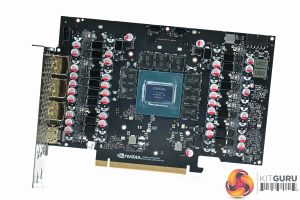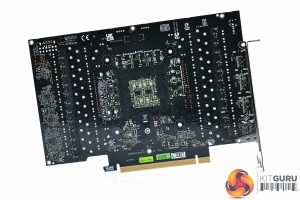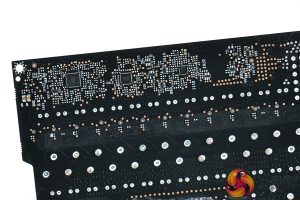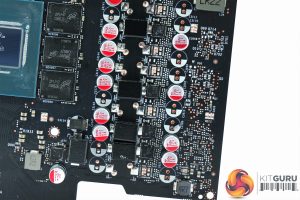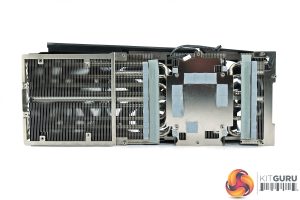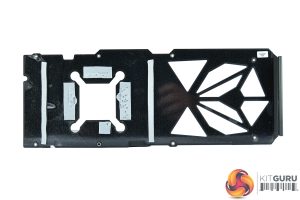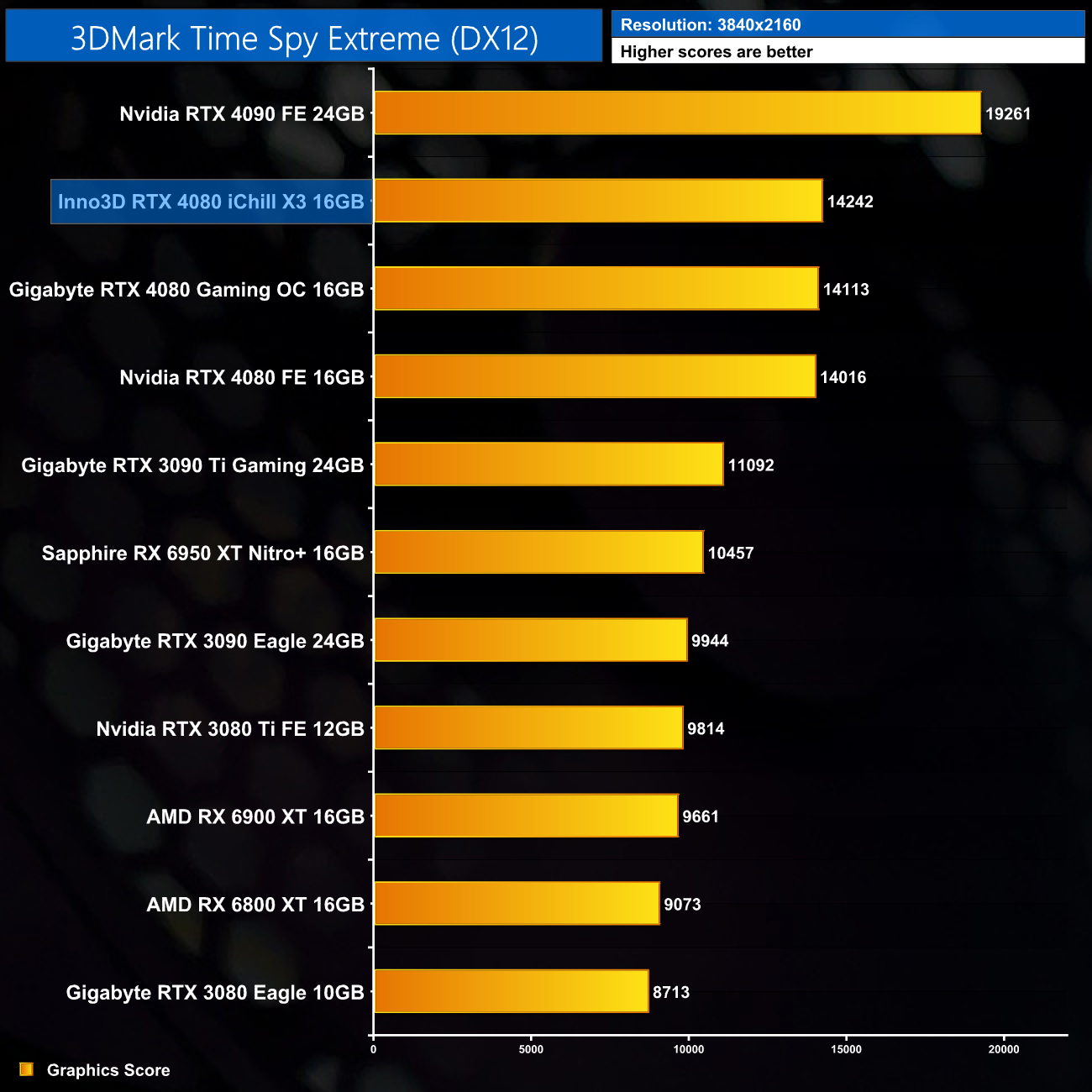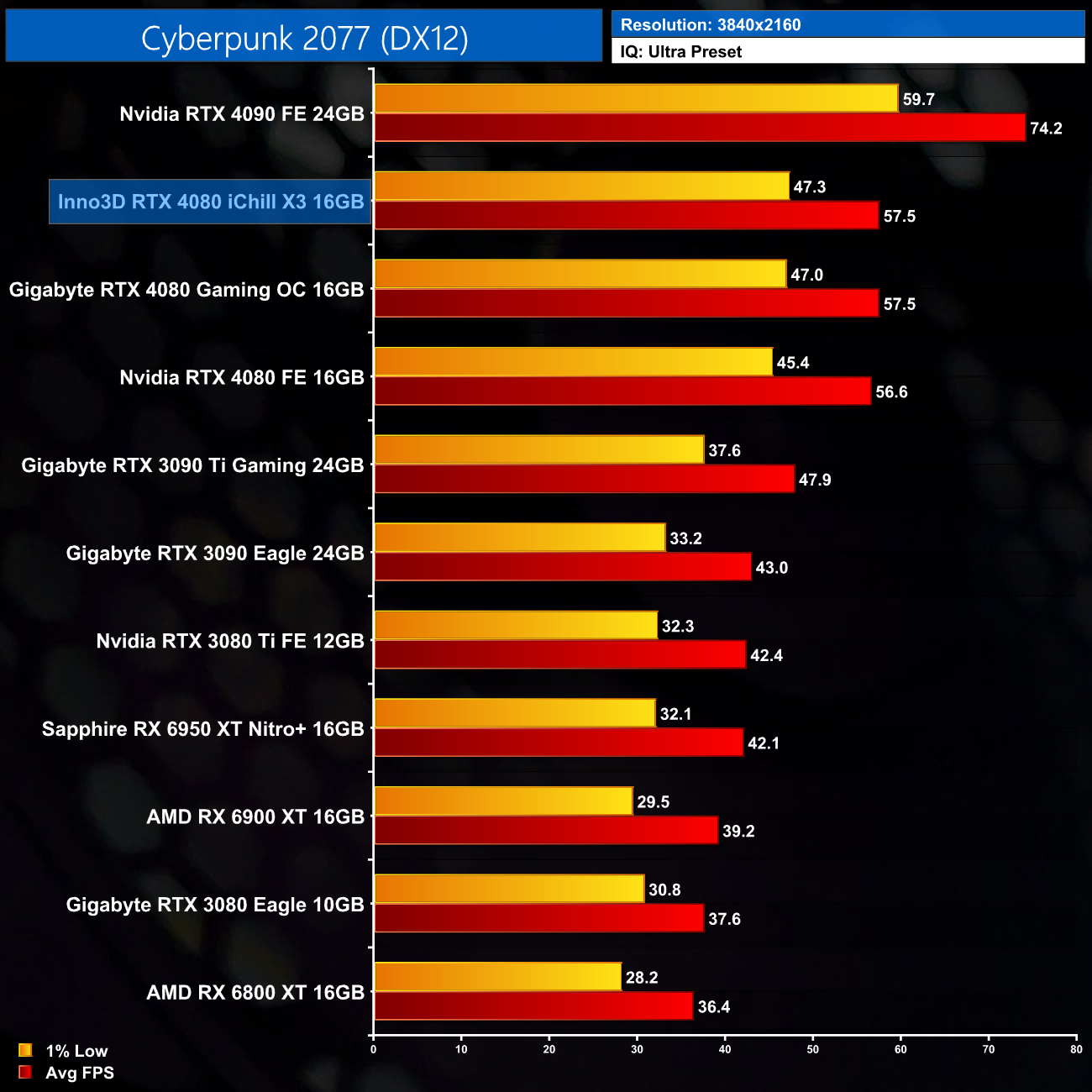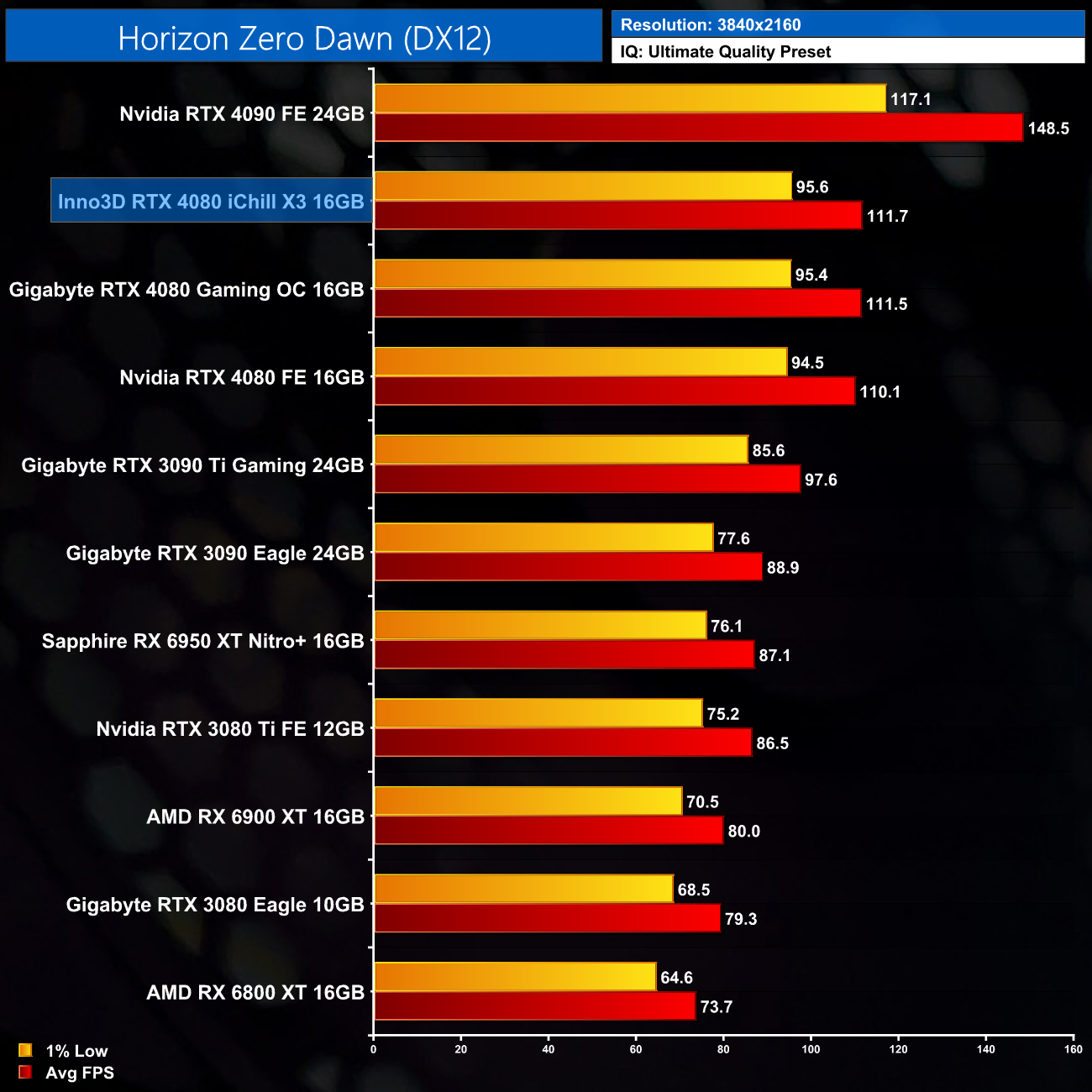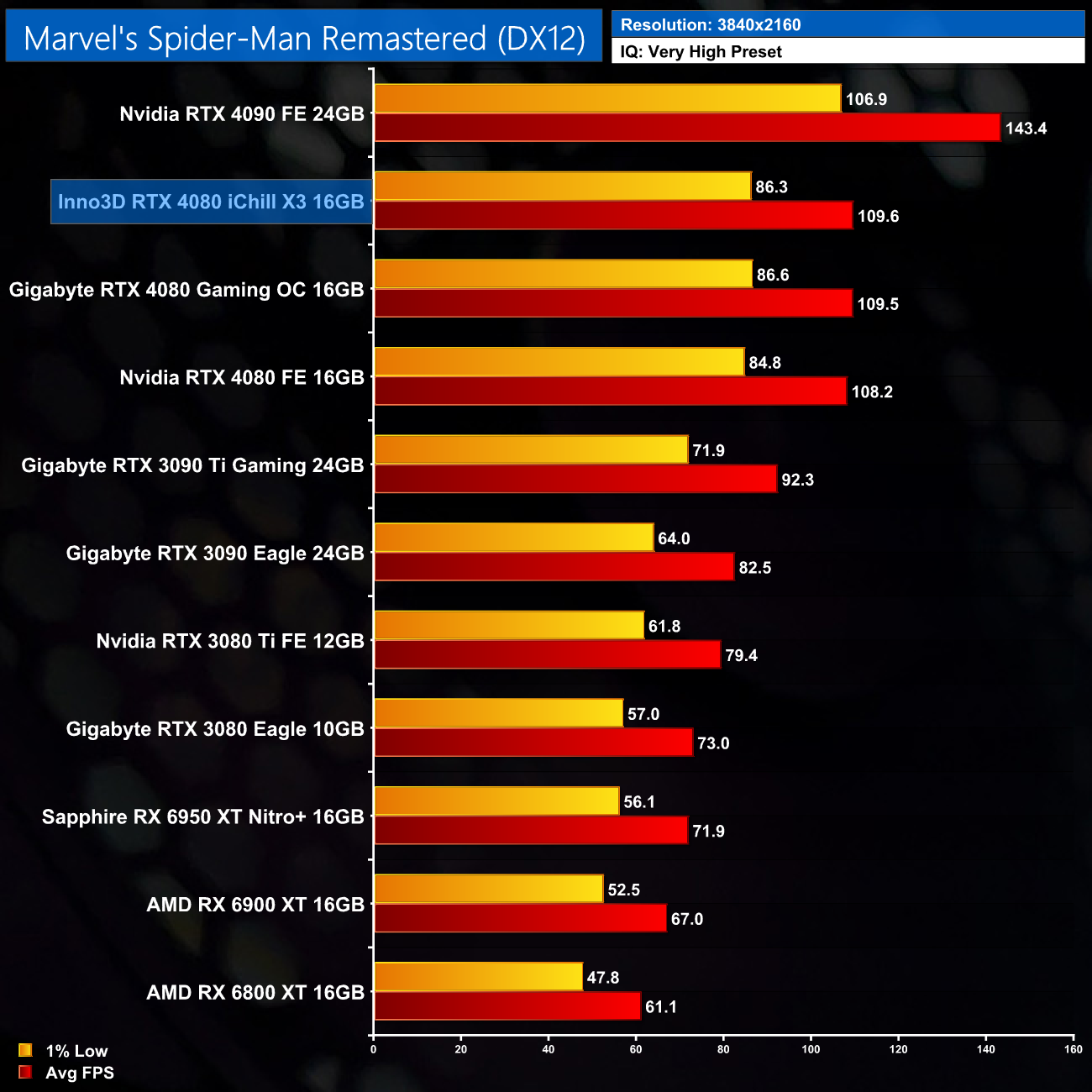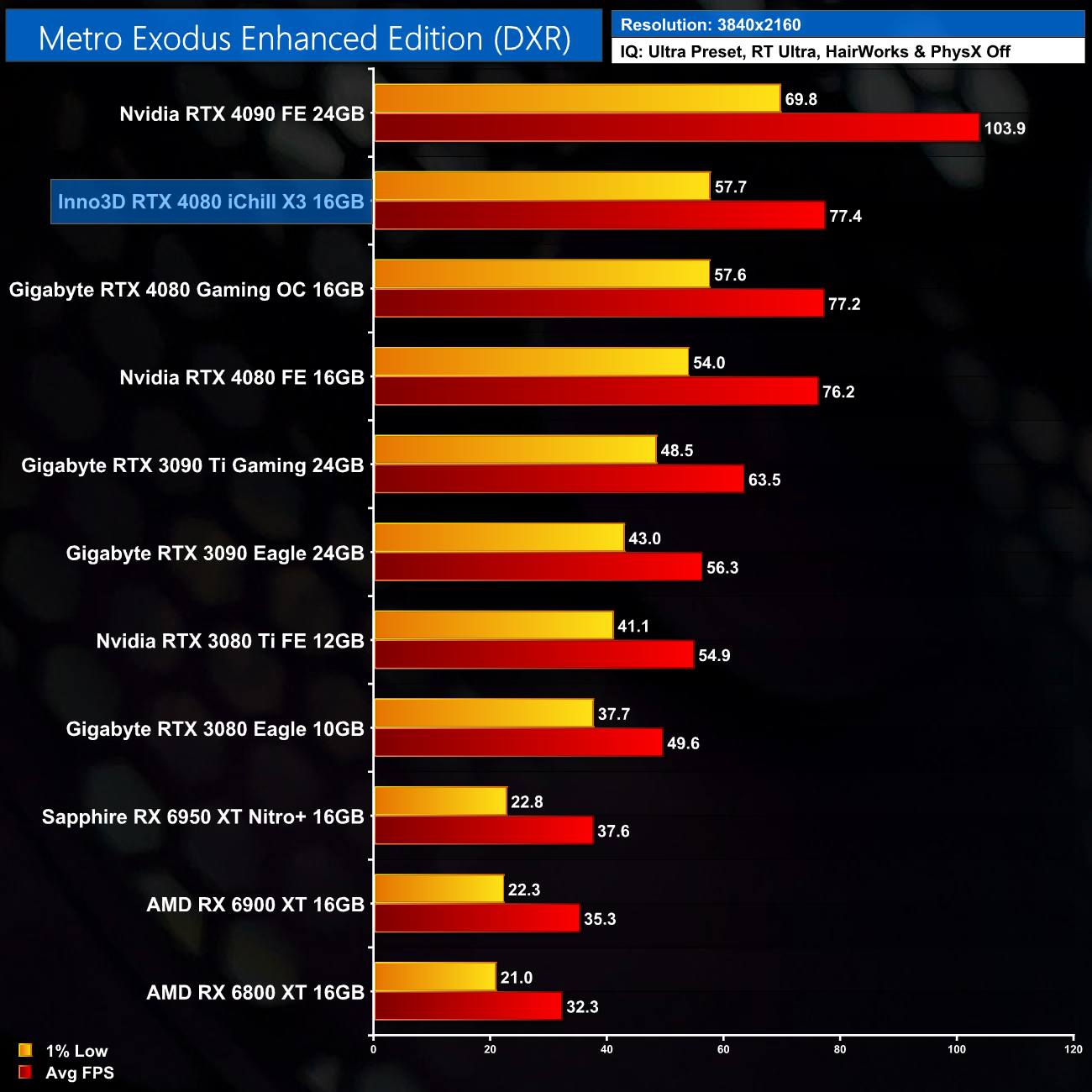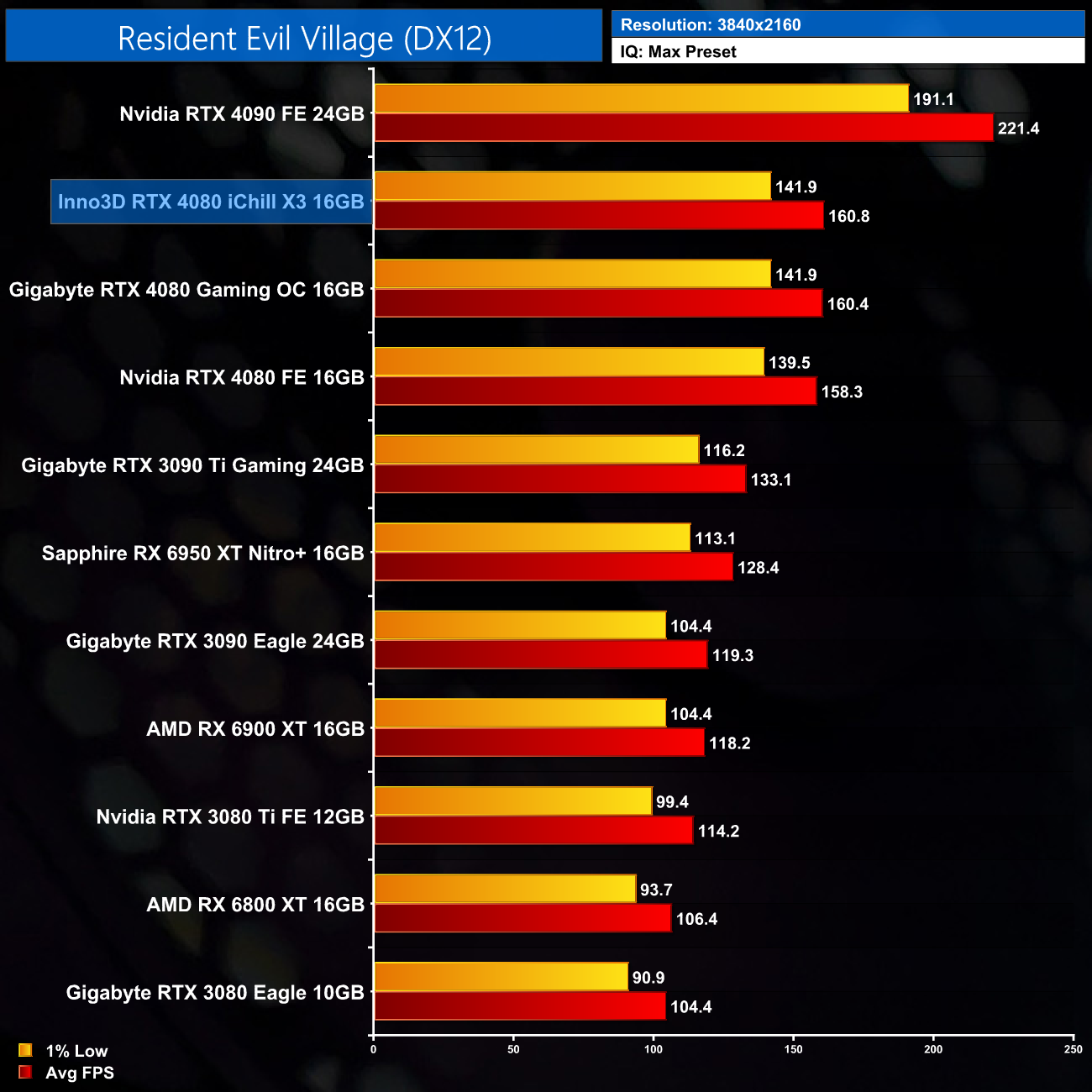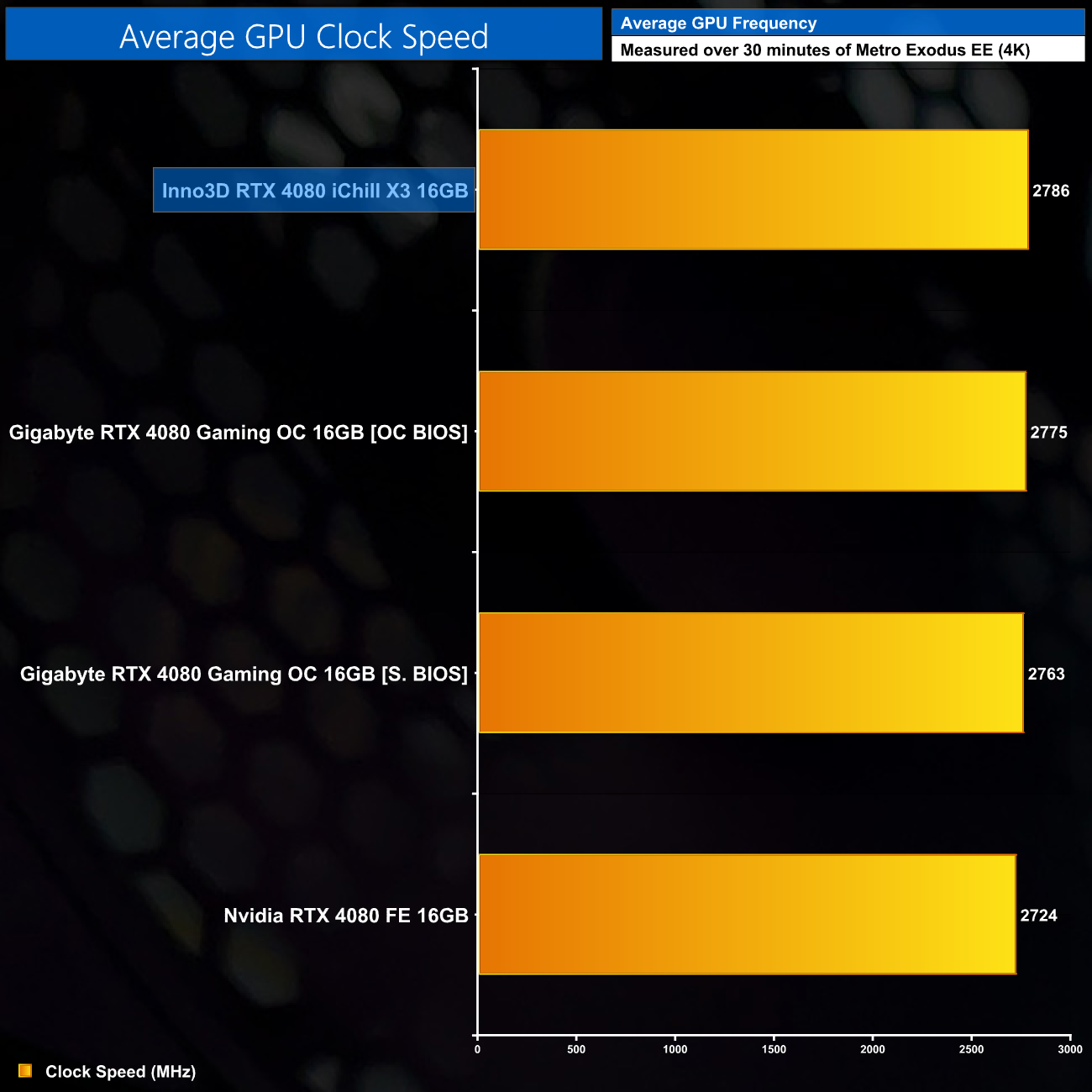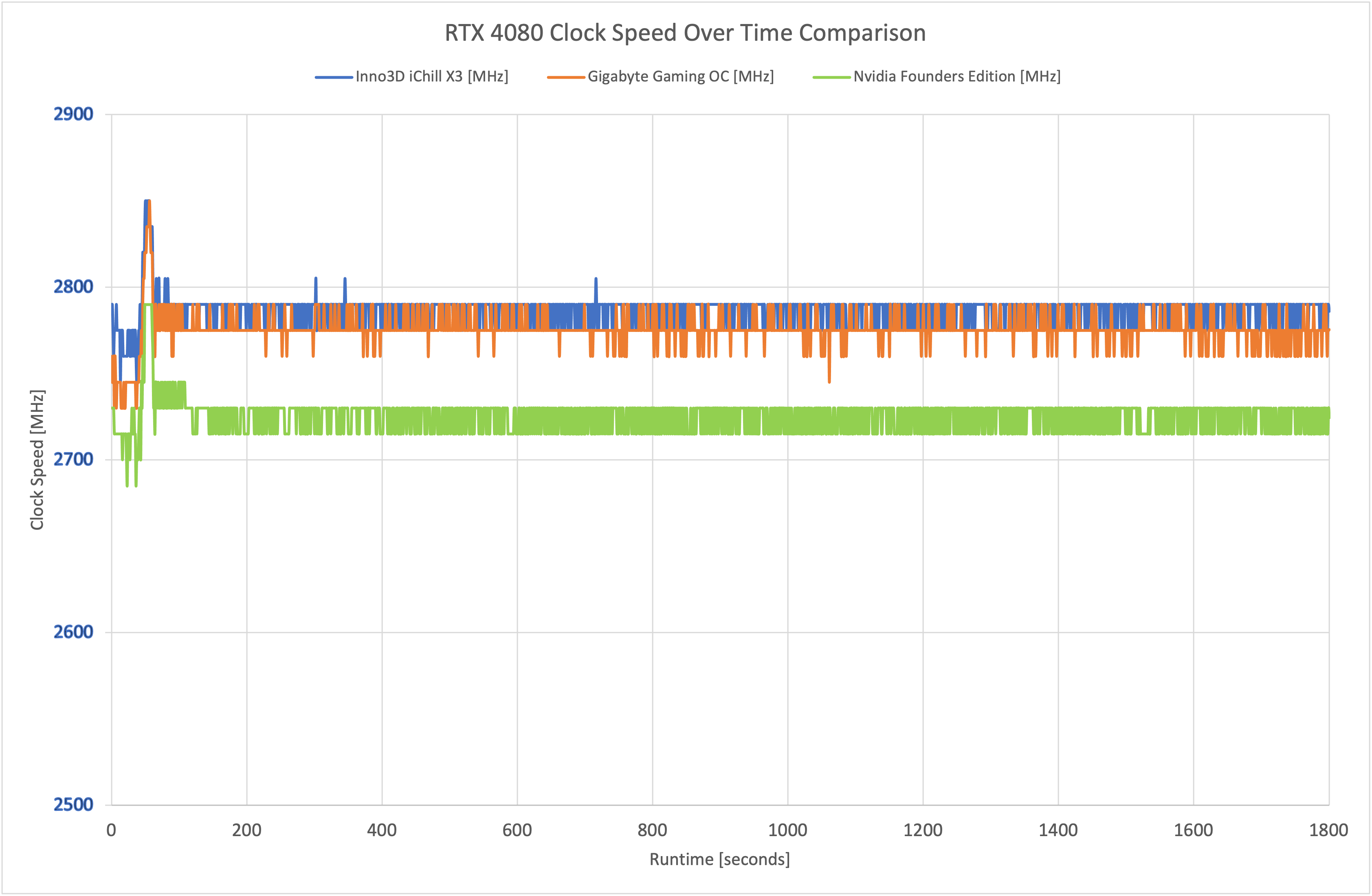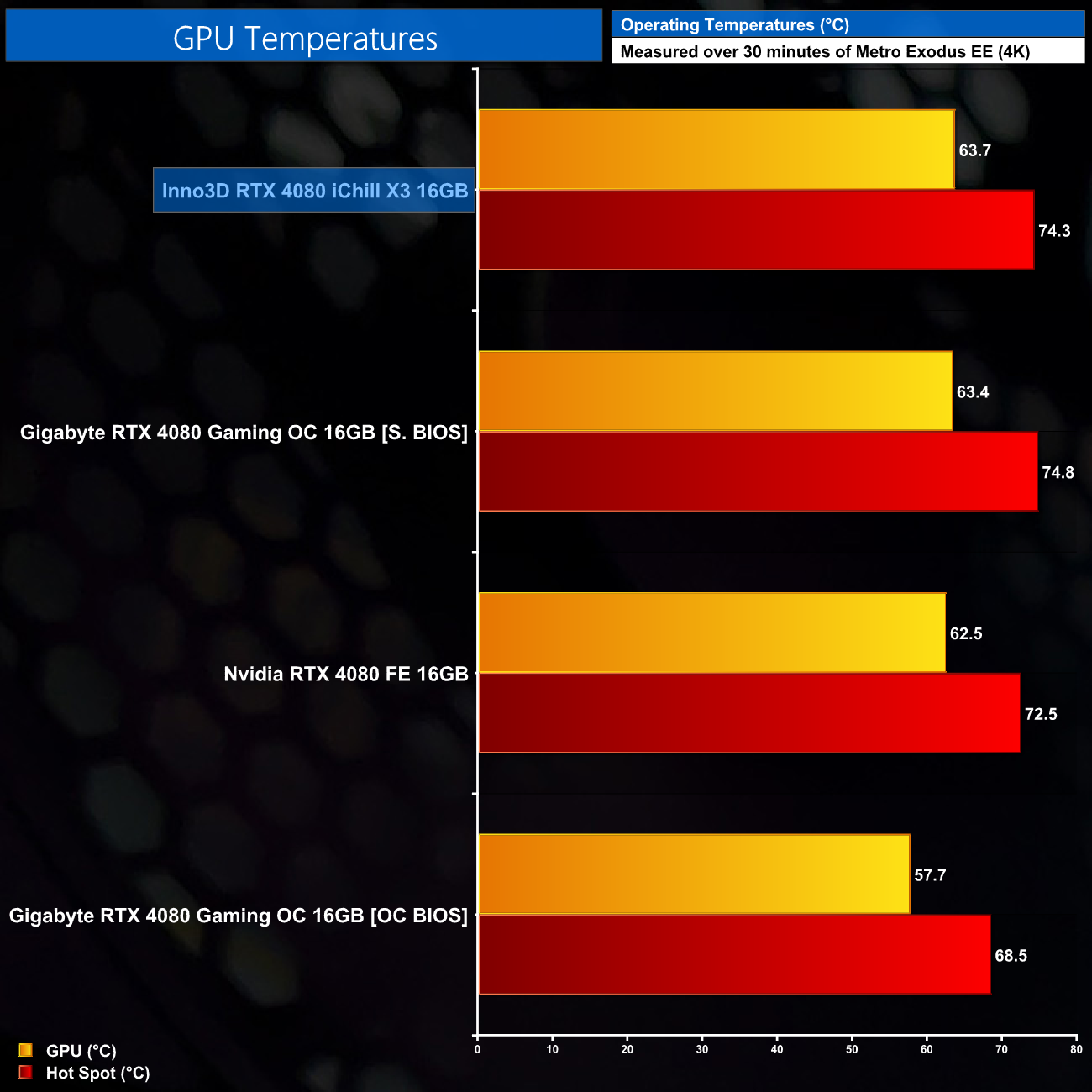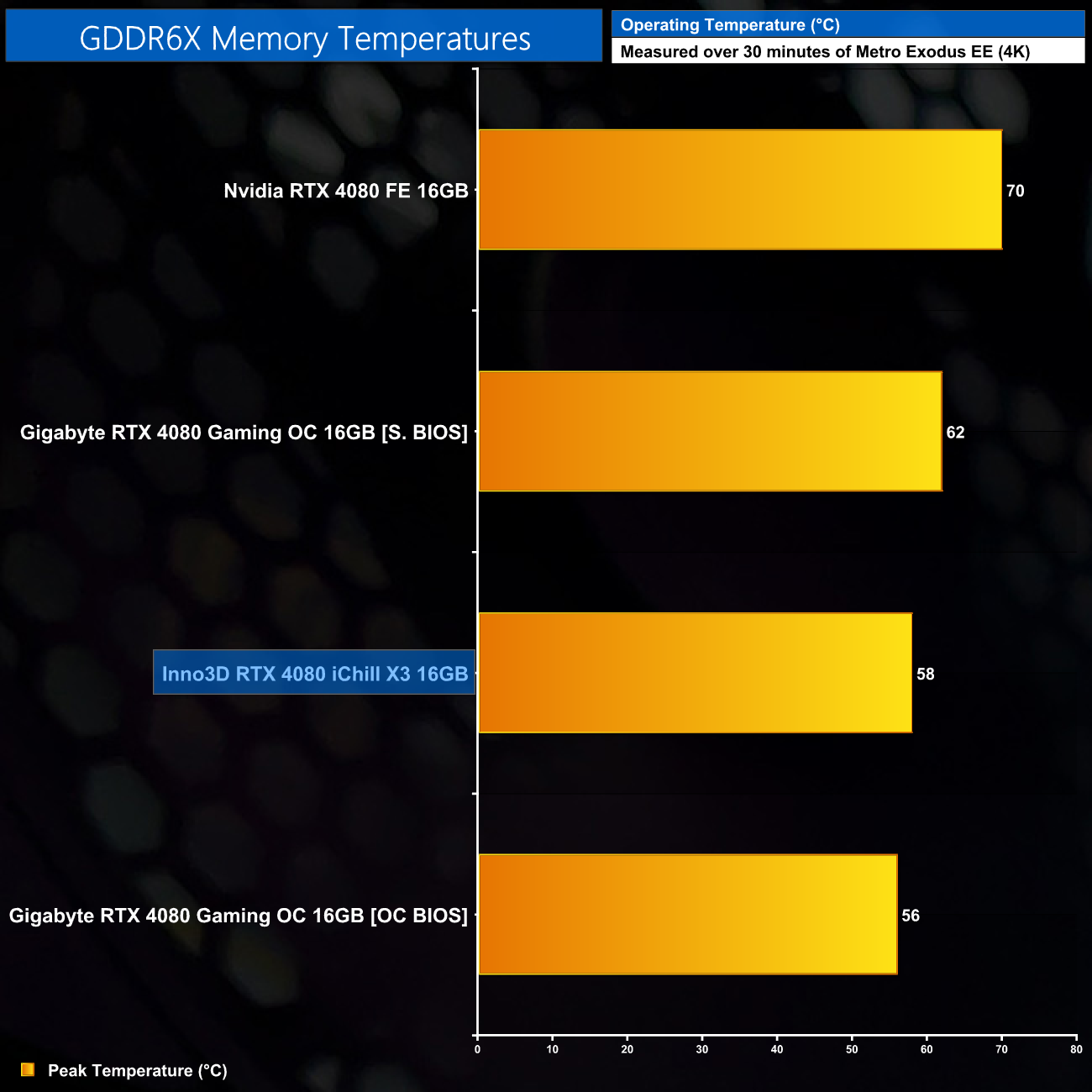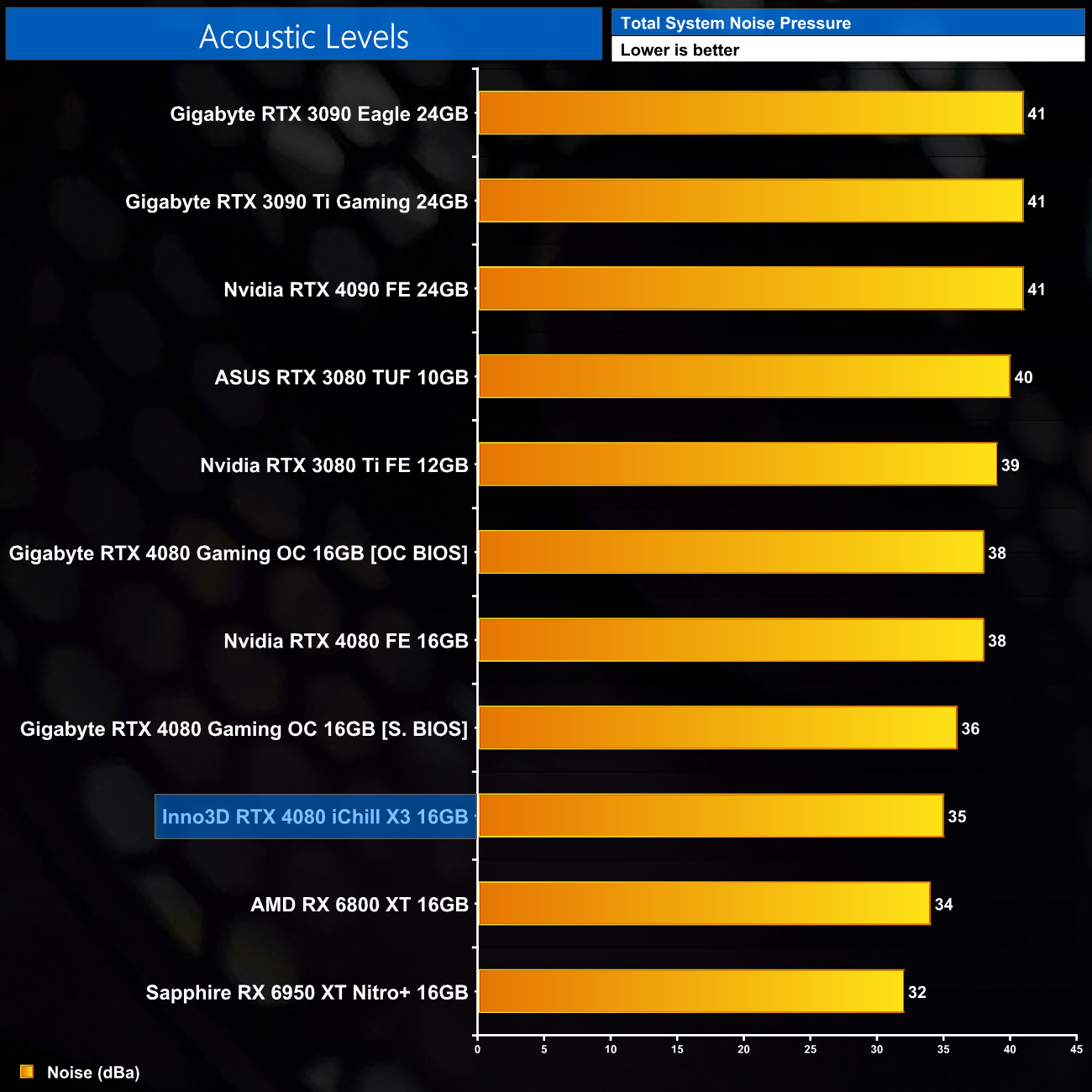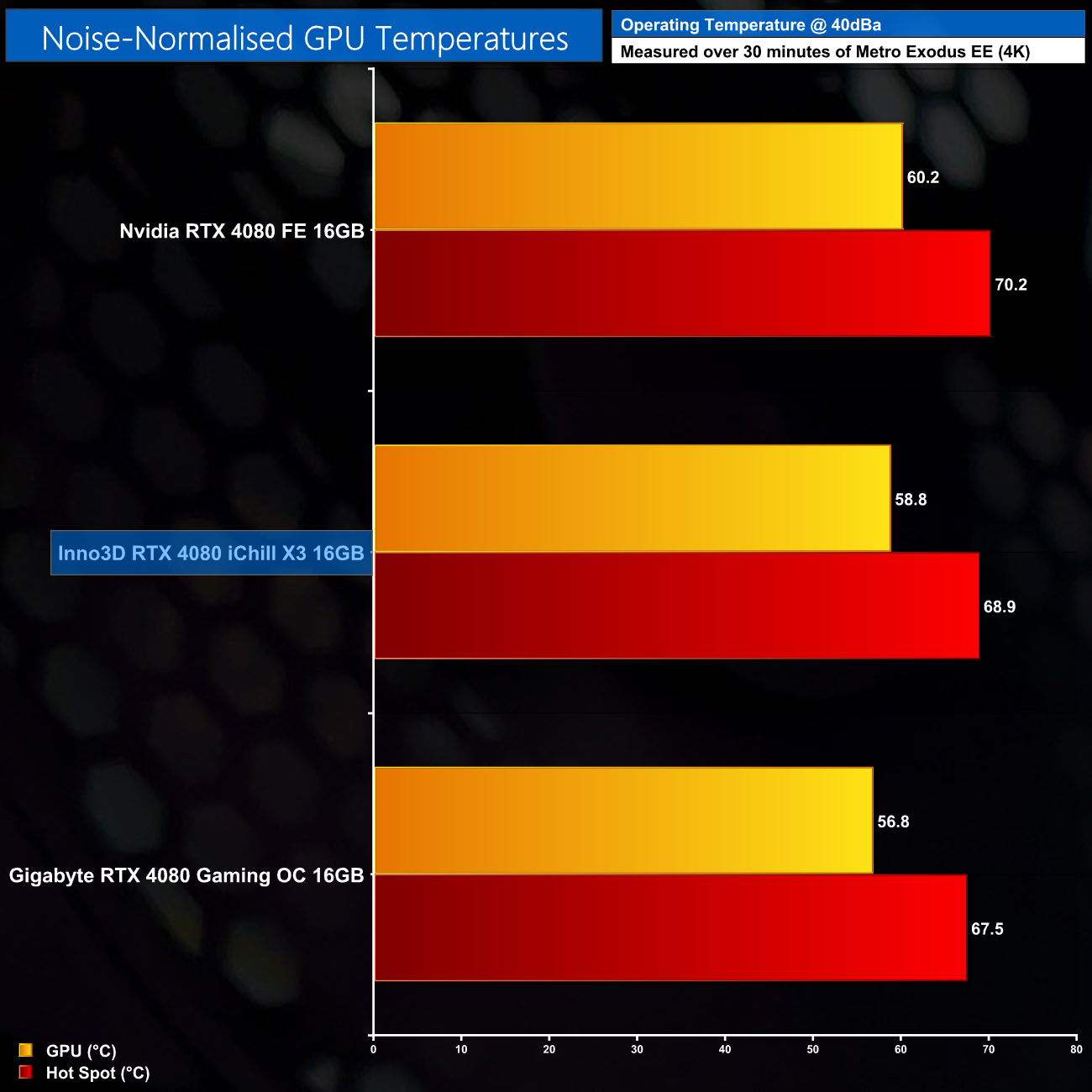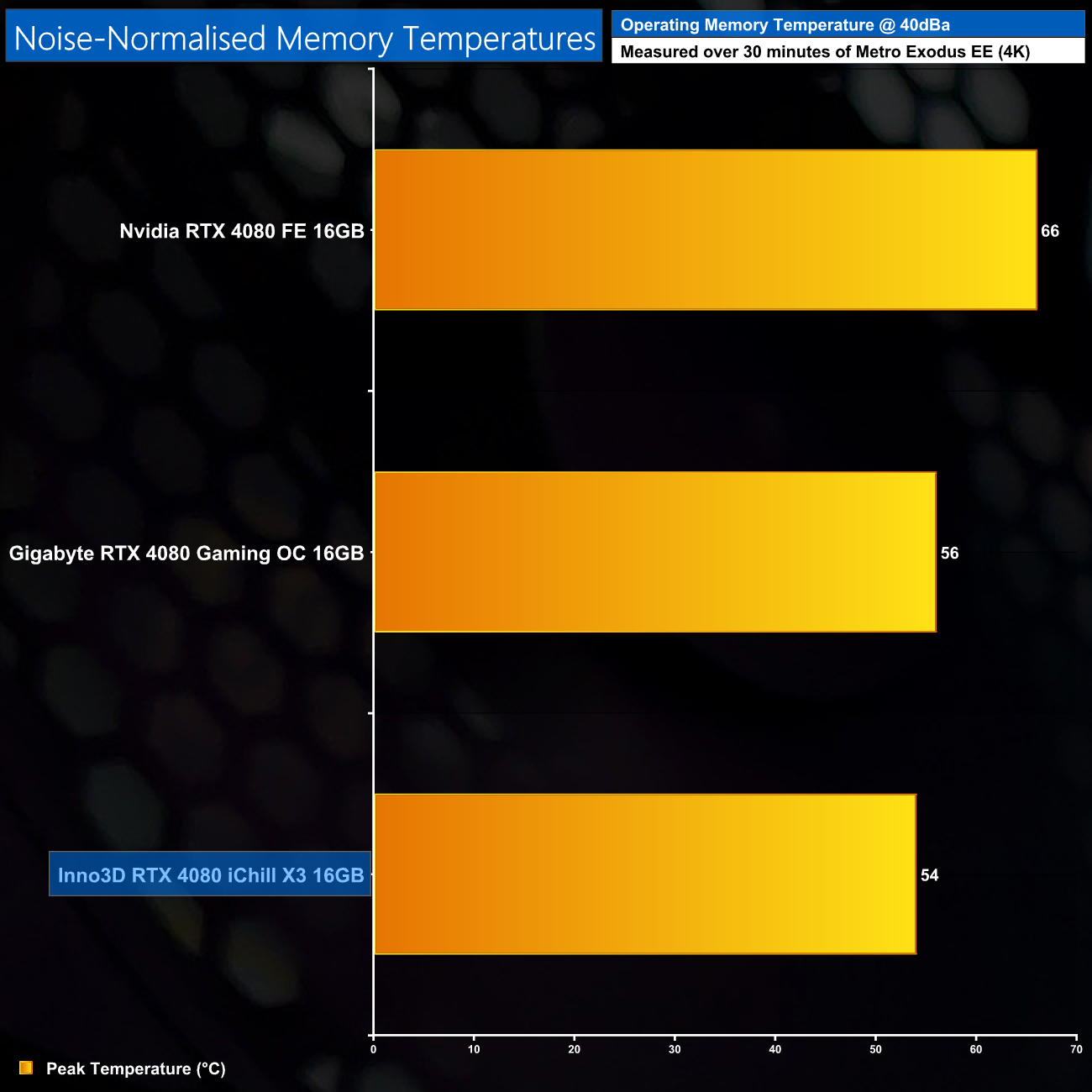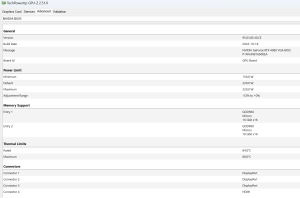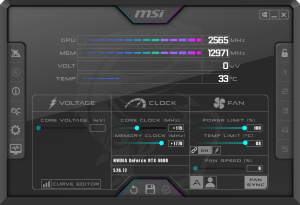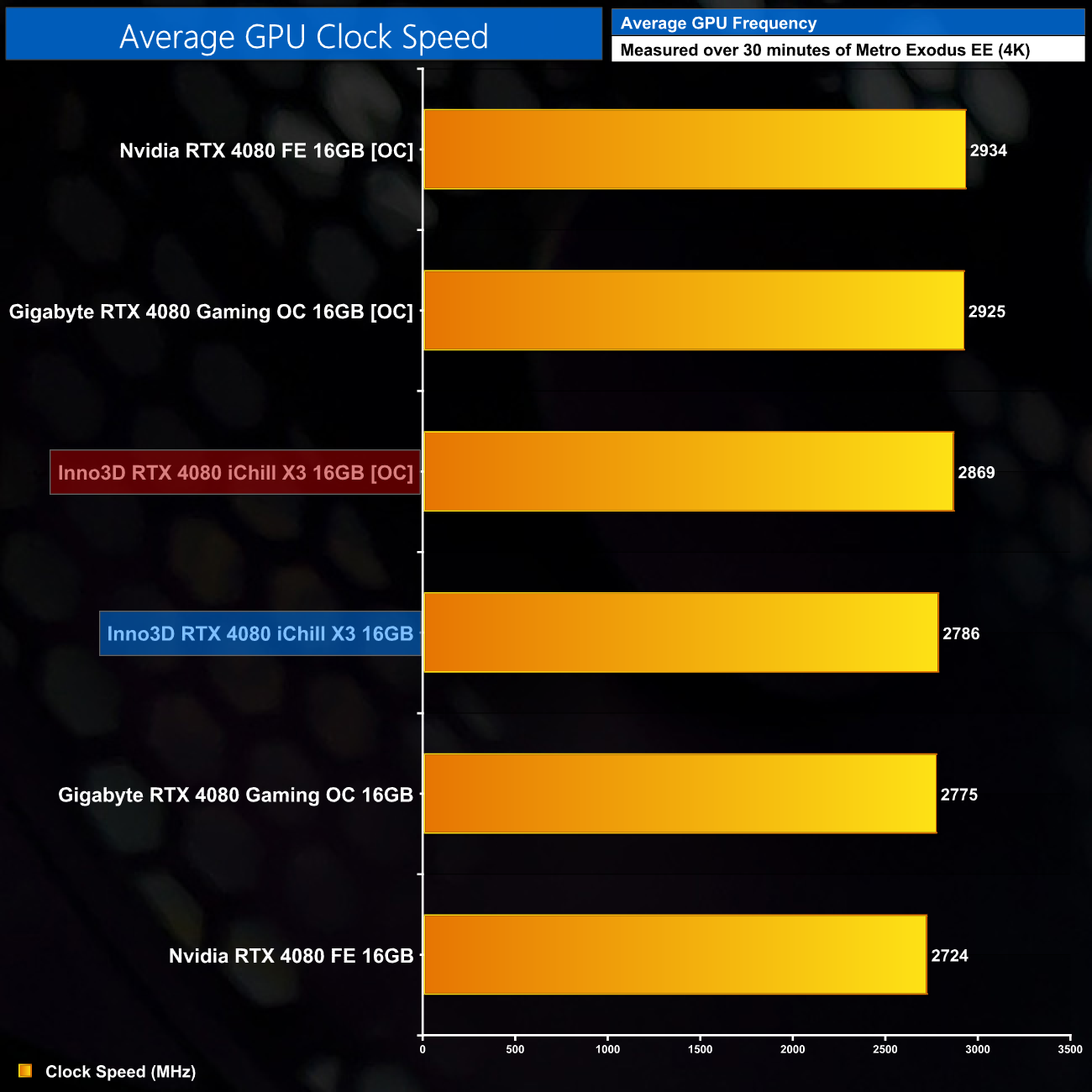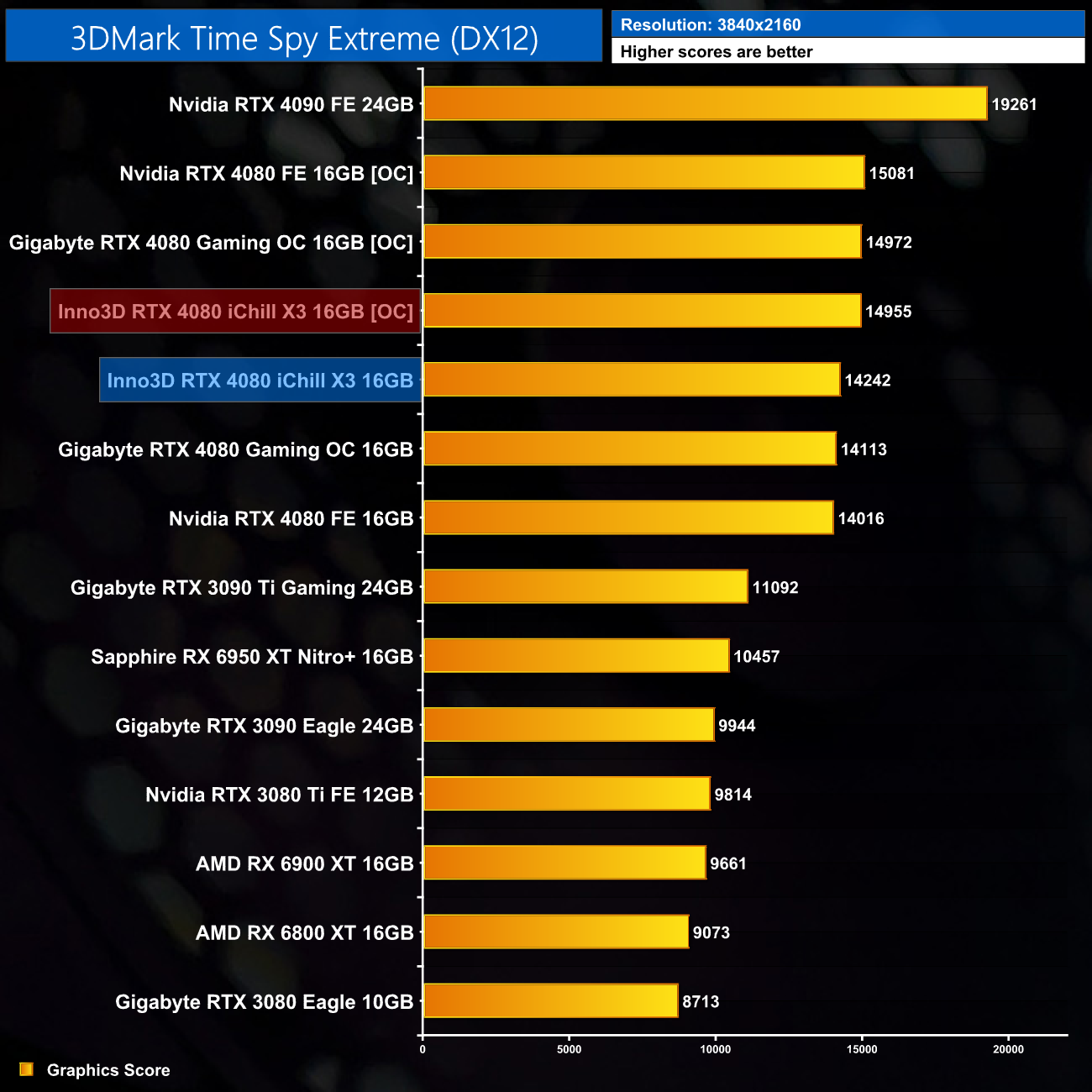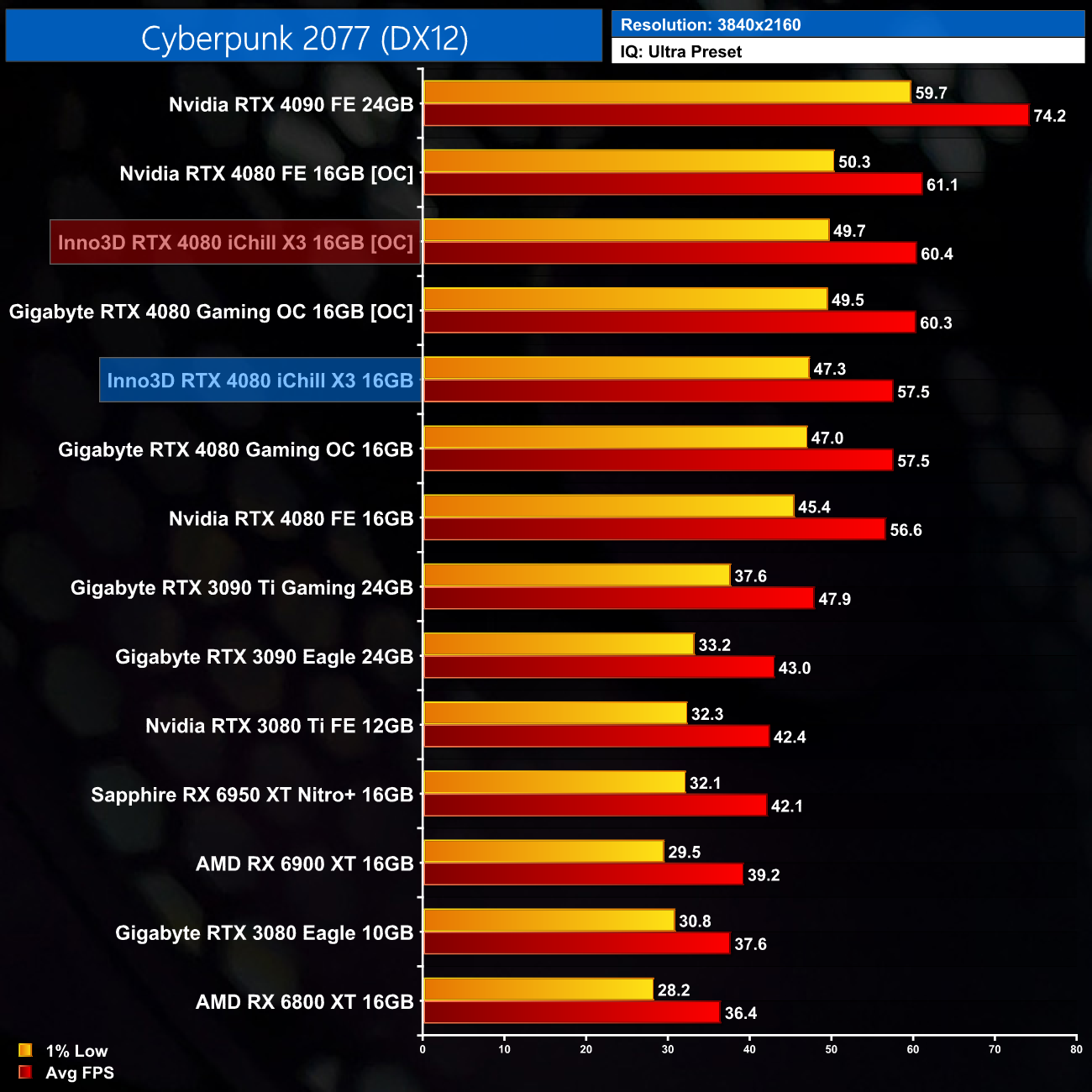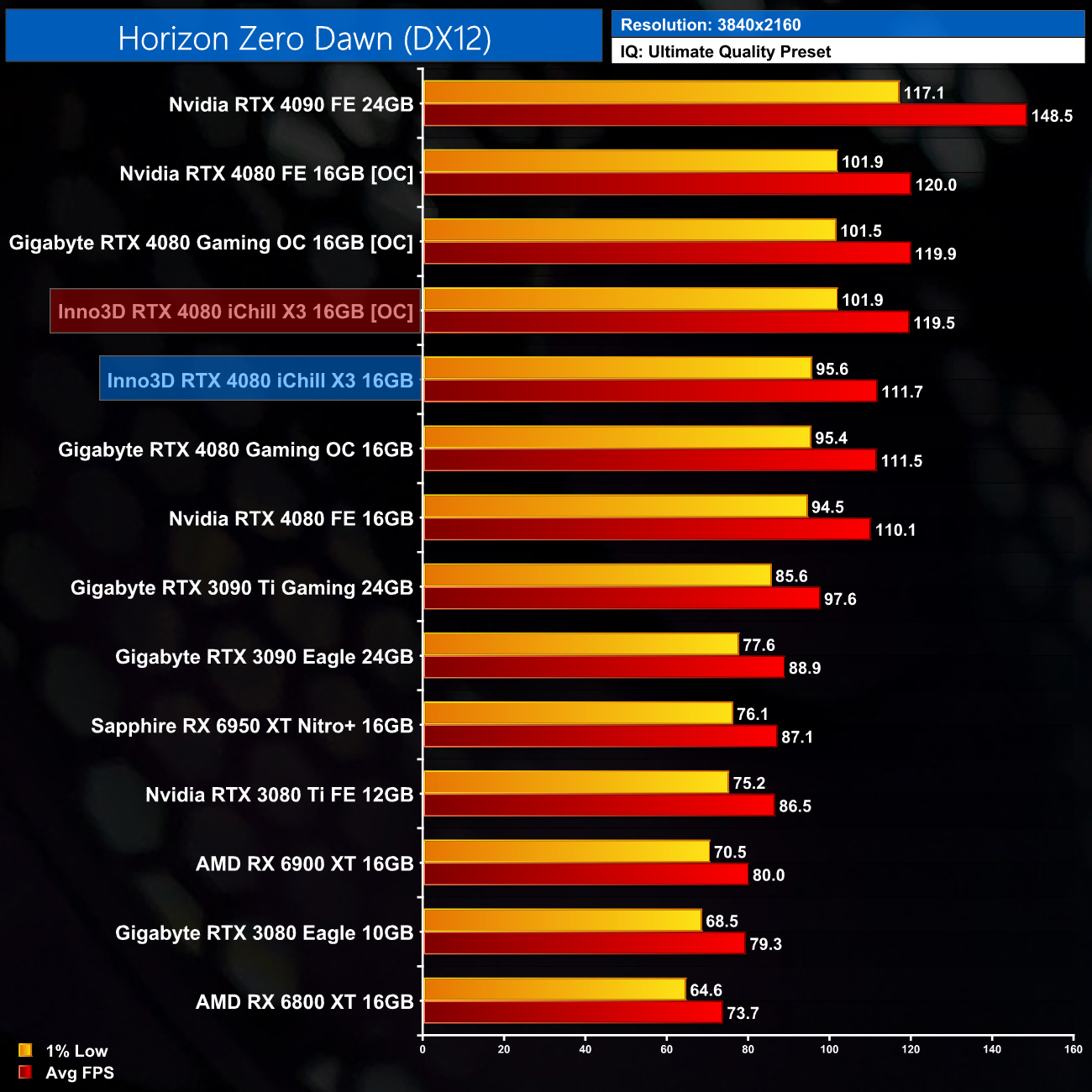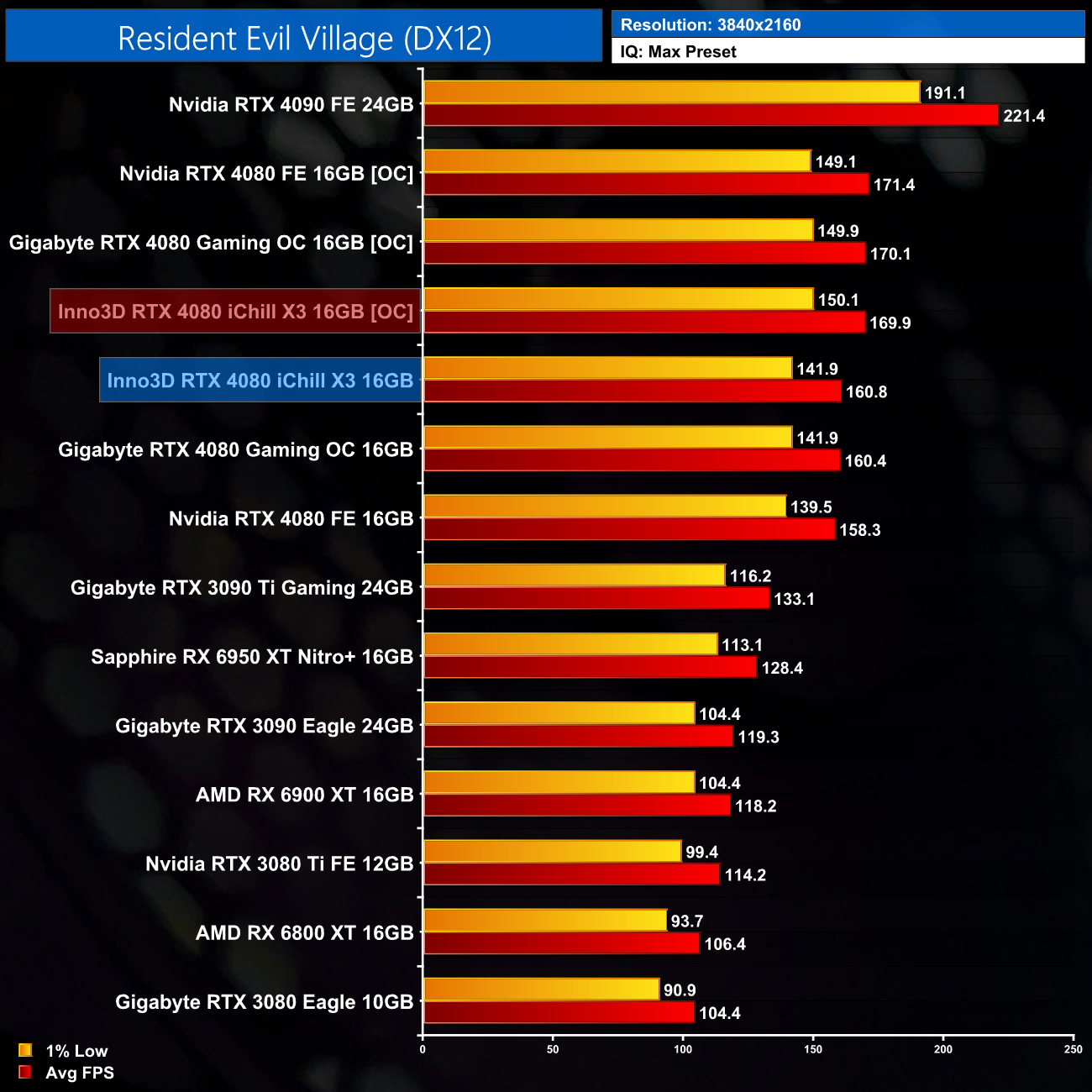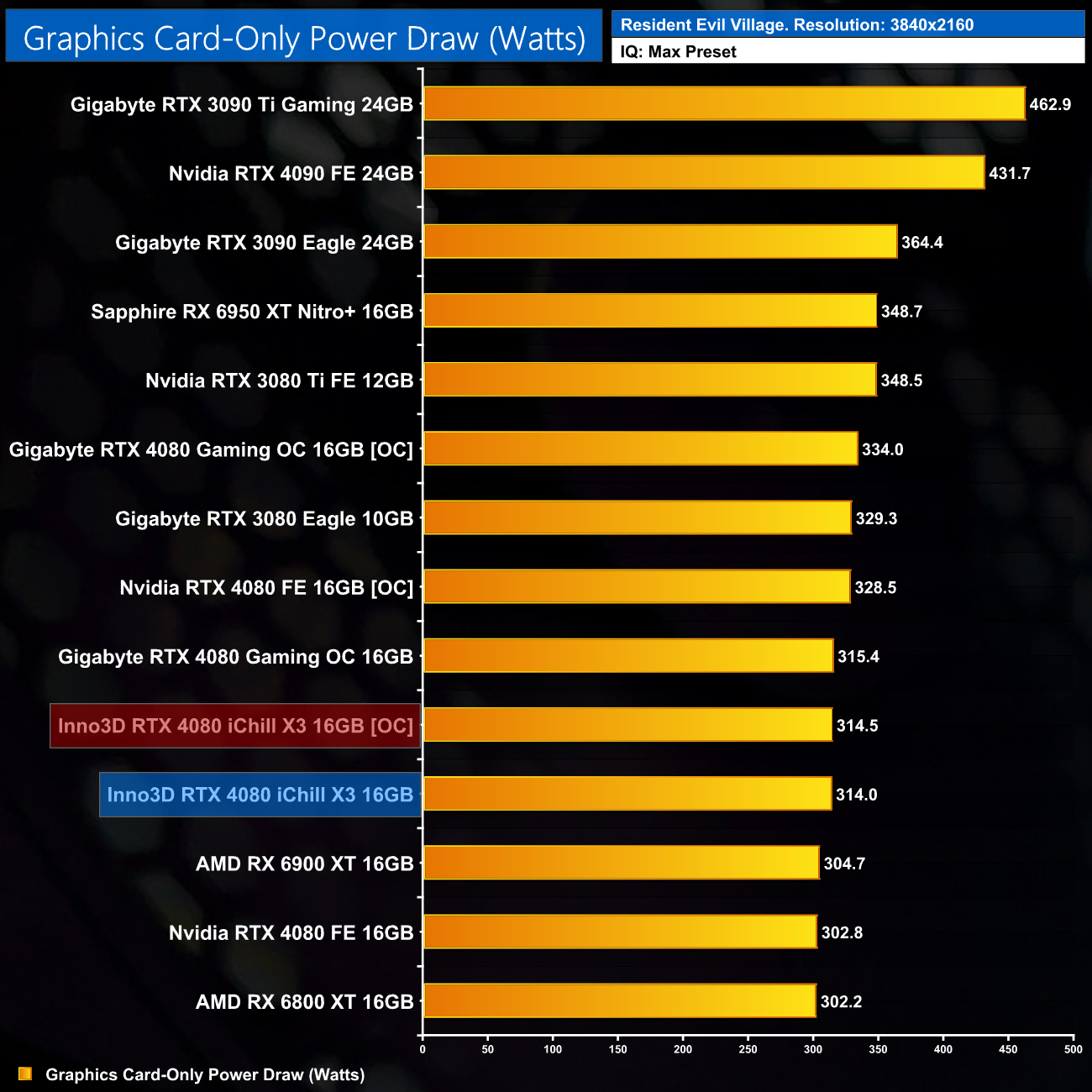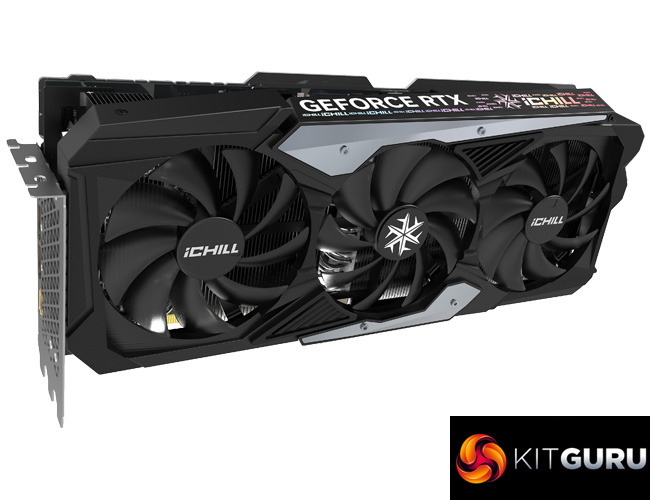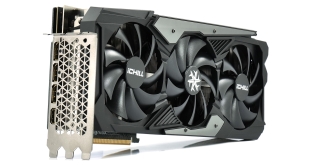
Today we continue our coverage of the RTX 4080 with a look at the Inno3D iChill X3 model. Sporting an eye-catching shroud design and 60MHz factory, the iChill X3 is also noteworthy as the first RTX 40-series graphics card we have reviewed that does not utilise a vapour chamber cooler. What will that mean for thermal performance? We find out today…
Alongside the aggressive design and increased clock frequency, the Inno3D RTX 4080 iChill X3 also boasts plentiful RGB lighting, a triple-slot and triple-fan cooling setup, and an included GPU holder. We put this card through its paces today and find out how it stacks up against the Nvidia Founders Edition, as well as Gigabyte's Gaming OC.
| RTX 4090 | RTX 4080 | RTX 3090 Ti | RTX 3090 | RTX 3080 Ti | RTX 3080 | |
| Process | TSMC N4 | TSMC N4 | Samsung 8N | Samsung 8N | Samsung 8N | Samsung 8N |
| SMs | 128 | 76 | 84 | 82 | 80 | 68 |
| CUDA Cores | 16384 | 9728 | 10752 | 10496 | 10240 | 8704 |
| Tensor Cores | 512 | 304 | 336 | 328 | 320 | 272 |
| RT Cores | 128 | 76 | 84 | 82 | 80 | 68 |
| Texture Units | 512 | 304 | 336 | 328 | 320 | 272 |
| ROPs | 176 | 112 | 112 | 112 | 112 | 96 |
| GPU Boost Clock | 2520 MHz | 2505 MHz | 1860 MHz | 1695 MHz | 1665 MHz | 1710 MHz |
| Memory Data Rate | 21 Gbps | 22.4 Gbps | 21 Gbps | 19.5 Gbps | 19 Gbps | 19 Gbps |
| L2 Cache | 73729 KB | 65536 KB | 6144 KB | 6144 KB | 6144 KB | 5120 KB |
| Total Video Memory | 24GB GDDR6X | 16GB GDDR6X | 24GB GDDR6X | 24GB GDDR6X | 12GB GDDR6X | 10GB GDDR6X |
| Memory Interface | 384-bit | 256-bit | 384-bit | 384-bit | 384-bit | 320-bit |
| Memory Bandwidth | 1008 GB/Sec | 716.8 GB/Sec | 1008 GB/Sec | 936 GB/Sec | 912 GB/Sec | 760 GB/Sec |
| TGP | 450W | 320W | 450W | 350W | 350W | 320W |
First, for a quick spec recap. RTX 4080 uses the AD103 die, and this is notably smaller than AD102, measuring 378.6mm2. Accordingly, transistor count is reduced from 76.3 billion, down to 45.9 billion. The fundamental building blocks are still the same of course, with the RTX 4080 offering a total of 84 Streaming Multiprocessors (SMs), each housing 256 CUDA Cores, for a total of 9728. We also find 84 RT cores, 336 Tensor cores, 336 Texture Units, and 112 ROPs.
TSMC's N4 node has Nvidia cranking up the clock speed significantly this generation, with the RTX 4080 sporting a 2505MHz rated boost clock. Inno3D has increased this further with a 60MHz factory overclock.
The memory configuration is another area where AD103 has been cut-back significantly. The memory interface has been reduced to 256-bit, and even with 16GB GDDR6X running at 22.4Gbps, that cuts memory bandwidth down to 716.6GB/s. That said, there has been a substantial upgrade to the L2 cache with the Ada architecture, with the RTX 4080 now offering 65.5MB, compared to just 6MB for GA102.
Considering RTX 4080 is notably cut-down versus the RTX 4090, rated power draw is lower, with a 320W TGP. Inno3D has not increased this out of the box.
The Inno3D RTX 4080 iChill X3 ships in a black box, with an image of the graphics card visible on the front. On the back, Inno3D highlights various key features of the card in multi-lingual text.
Inside, a couple of pieces of documentation are included. We also find a triple 8-pin adapter for the 12VHPWR connector, as well as an ARGB cable that can be used to synchronise the card's LEDs with your motherboard. A fairly basic GPU holder is also included, which simply takes some weight off the card to alleviate pressure on the PCIe slot. It may not be particularly elegant but it gets the job done.
As for the card itself then, it’s immediately clear this is a card for “gamers”. What I mean by that is, it features an eye-catching design with aggressive angles and swooping lines – minimalistic or low-key, this is not. It may not be for everyone but at least it’s something a bit different, and I have to say I personally quite like it.
The shroud itself is made mostly from plastic, but it still feels pretty solid and rigid in the hand, and there are two grey metal plates that are screwed on top of the plastic. This does have some positive aspects, in the way of weight savings, as the iChill isn’t too heavy – it weighs in just over 1.8kg, so while it’s not exactly light, it is a couple hundred grams lighter than the Founders Edition.
We can also note three 98mm fans, while the central fan spins in reverse, an increasingly popular feature which just helps to reduce airflow turbulence, thus increasing air pressure down onto the heatsink.
In terms of its overall size, the iChill is not too large as RTX 40-series cards go. Granted, it’s not exactly small, measuring in at 334 x 148 x 62mm, but compared to the Founders Edition there’s not much in it – the iChill X3 is just a bit longer, but the height and width are pretty similar.
As expected, we find a metal backplate is fitted to the rear of the PCB, covering the length of the card but with several large cut-outs towards the end to aid airflow. The backplate is decorated with lots of small triangles too, simply adding some visual interest.
Interestingly, while there is small notch in the backplate where we’d typically expect to find a dual-BIOS switch, the card itself doesn’t actually feature dual-BIOS. We asked Inno3D about this and they told us they didn’t deem it necessary to include dual-BIOS, as the company didn’t think adding another mode with a higher power limit would bring any performance gain. While that may be true, I still think having a second BIOS option purely for redundancy, in case you accidentally brick one BIOS during an update or something, can only be a good thing – especially for a card of this price.
We show the RGB lighting at a greater length in the video review, but it's important to note a small 3-pin header is positioned on the side of the RGB zone. This is where you can connect the included ARGB cable, with the other end plugging into an ARGB header on your motherboard, allowing you to control the lighting that way if you prefer. It is slightly clunky to route another cable from the card, but it's better than not having the option at all.
The 12VHPWR connector is present on the side of the card, while display outputs are as standard with 3x DisplayPort 1.4 and 1x HDMI 2.1.
Moving on to disassembly of the card, the overall design of the PCB looks very similar to the 4090 X3 OC we reviewed back in October. Inno3D is using a 14-phase VRM for the GPU and a 3-phase VRM for the memory, with 55A Alpha and Omega AOZ5311NQI MOSFETs used across the board. UPI’s UP9512R is used to control the GPU VRM, with a Richtek RT8843 controller used for the memory VRM.
As mentioned in the introduction, the cooler is the first RTX 40-series card where the manufacturer has not opted to use a vapour chamber to contact the GPU and memory. Instead, we have a more traditional nickel-plated cooper baseplate, with a total of eight nickel-plated heatpipes.
We asked Inno3D why they didn’t use a vapour chamber and they told us that, for the RTX 4080, a copper baseplate offers better memory thermals than a vapour chamber – something we look at later in the review. I’d also add that a vapour chamber is surely more expensive than a copper baseplate too, and after all, the 4080 typically draws less than 300 Watts, so perhaps it’s just not worth the extra cost.
Lastly, we can see Inno3D is using thermal pads on the backplate to draw extra heat out from the rear of the PCB.
Driver Notes
- All AMD GPUs were benchmarked with the Adrenalin 22.10.3 driver.
- All Nvidia GPUs (except RTX 4080) were benchmarked with the 526.61 driver.
- RTX 4080 was benchmarked with the 527.72 driver supplied to press.
Benchmark results are only comparable where this exact configuration has been used.
Test System:
We test using a custom built system powered by MSI, based on Intel’s Alder Lake platform. You can read more about this system HERE and check out MSI on the CCL webstore HERE.
| CPU |
Intel Core i9-12900K
|
| Motherboard |
MSI MEG Z690 Unify
|
| Memory |
32GB (2x16GB) ADATA XPG Lancer DDR5 6000MHz
CL 40-40-40
|
| Graphics Card |
Varies
|
| SSD |
2TB MSI Spatium M480
|
| Chassis | MSI MPG Velox 100P Airflow |
| CPU Cooler |
MSI MEG CoreLiquid S360
|
| Power Supply |
Corsair 1200W HX Series Modular 80 Plus Platinum
|
| Operating System |
Windows 11 Pro 21H2
|
| Monitor |
MSI Optix MPG321UR-QD
|
| Resizable BAR |
Enabled for all supported GPUs
|
Comparison Graphics Cards List
- Sapphire RX 6950 XT Nitro+ 16GB
- AMD RX 6900 XT 16GB
- AMD RX 6800 XT 16GB
- Nvidia RTX 4090 Founders Edition 24GB
- Nvidia RTX 4080 Founders Edition 16GB
- Gigabyte RTX 4080 Gaming OC 16GB
- Gigabyte RTX 3090 Ti Gaming 24GB
- Gigabyte RTX 3090 Eagle 24GB
- Nvidia RTX 3080 Ti Founders Edition 12GB
- Gigabyte RTX 3080 Eagle 10GB
All cards (except RTX 4080 AIB models) were tested at reference specifications.
Software and Games List
- 3DMark Fire Strike & Fire Strike Ultra (DX11 Synthetic)
- 3DMark Time Spy (DX12 Synthetic)
- 3DMark DirectX Raytracing feature test (DXR Synthetic)
- Assassin's Creed Valhalla (DX12)
- Cyberpunk 2077 (DX12)
- Days Gone (DX11)
- Dying Light 2 (DX12)
- Far Cry 6 (DX12)
- Forza Horizon 5 (DX12)
- God of War (DX11)
- Horizon Zero Dawn (DX12)
- Marvel's Spider-Man Remastered (DX12)
- Metro Exodus Enhanced Edition (DXR)
- Red Dead Redemption 2 (DX12)
- Resident Evil Village (DX12)
- Total War: Warhammer III (DX11)
We run each benchmark/game three times, and present mean averages in our graphs. We use FrameView to measure average frame rates as well as 1% low values across our three runs.
3DMark Time Spy is a DirectX 12 benchmark test for Windows 10 gaming PCs. Time Spy is one of the first DirectX 12 apps to be built the right way from the ground up to fully realize the performance gains that the new API offers. With its pure DirectX 12 engine, which supports new API features like asynchronous compute, explicit multi-adapter, and multi-threading, Time Spy is the ideal test for benchmarking the latest graphics cards. (UL).
3DMark Time Spy Extreme is an early look at performance, with the iChill X3 OC scoring 14242 points – about 130 ahead of the Gigabyte RTX 4080 Gaming OC.
Here we test five games, all at 3840×2160 resolution using maximum image quality settings.
As expected, gaming performance is very close to the other RTX 4080s we have tested. In fact, we never saw the iChill X3 come in more than 2% faster than the Founders Edition, so there’s really no tangible difference in terms of actual frame rates, which is why we never recommend buying a card based on the factory overclock.
Here we present the average clock speed for each graphics card while running Metro Exodus Enhanced Edition for 30 minutes. We use GPU-Z to record the GPU core frequency during gameplay. We calculate the average core frequency during the 30-minute run to present here.
Considering the gaming benchmarks on the previous page, it's no surprise to see such similar clock speed behaviour. We can see from the scatter graph how close the iChill is to the Gaming OC, as both ran essentially as fast as each other over our thirty-minute stress test. In fact, the iChill averaged 2786MHz, just 11MHz ahead of the Gaming OC’s OC BIOS.
For our temperature testing, we measure the peak GPU core temperature under load. A reading under load comes from running Metro Exodus Enhanced Edition for 30 minutes.
Moving onto thermal performance, we can see that the iChill X3 does sit at the top of the chart, coming in fractionally hotter than Nvidia’s Founders Edition and the Gigabyte Gaming OC when using the Silent BIOS. That said, a peak GPU temperature that’s below 64C is hardly worth complaining about, while the hot spot is under 75C as well.
For our temperature testing, we measure the peak memory temperature under load. A reading under load comes from running Metro Exodus Enhanced Edition for 30 minutes.
Memory thermals are better still however, with a peak temperature of just 58C. Bear in mind that this is all using the default fan curve, so these results don’t take noise levels into account.
We take our noise measurements with the sound meter positioned 1 foot from the graphics card. I measured the noise floor to be 32 dBA, thus anything above this level can be attributed to the graphics cards. The power supply is passive for the entire power output range we tested all graphics cards in, while all CPU and system fans were disabled. A reading under load comes from running Metro Exodus Enhanced Edition for 30 minutes.
The Inno3D iChill X3 is the quietest 4080 we’ve tested, producing just 35 dBa of noise – making it quieter than the Gigabyte Gaming OC, even when using the Silent BIOS. We saw the fans spin at just 1250rpm, or 39% speed.
Following on from our stock thermal and acoustic testing, here we re-test the operating temperature of the GPU, but with noise levels normalised to 40dBa. This allows us to measure the efficiency of the overall cooling solution as varying noise levels as a result of more aggressive fan curves are no longer a factor.
For our noise-normalised thermal results, we increased fan speed up to 52%, or 1630rpm. This saw the GPU temperature drop to 58.8C, which is still a couple degrees hotter than the Gaming OC, but it is now slightly cooler than the Founders Edition.
Noise-normalised memory thermals are the best we have seen so far however, with a reading of 54C. This does support Inno3D’s claim that a copper baseplate can offer better memory thermals than a vapour chamber, though there’s not much in it.
We use Nvidia PCAT to measure power draw of the graphics card only, with readings from both the PCIe slot and the PCIe power cables combined into a single figure. We use Resident Evil Village (4K) for this testing.
As for power draw, it’s important to note that the iChill X3 has not increased the power limit of the card, so it’s still rated for 320W like the Founders Edition. In practice, we saw it draw 314W in Resident Evil Village at 4K, so very similar to the Gigabyte Gaming OC
For our manual overclocking tests, we used MSI Afterburner. Our best results are as below.
Of course, we did try to manually overclock the card ourselves, but it’s important to note that you can’t actually increase the power limit of the card – it’s locked at 100% and cannot be raised above 320W. Inno3D told us this is because it doesn’t actually affect overclocking, considering the 4080 is voltage limited and not power limited. That does seem to be the case based on my findings, though it can depend on the scenario and specific game.
We were still able to add 115MHz to the GPU and 1770MHz to the GDDR6X memory.
Over our 30 minute stress test, the card did run a bit slower than the likes of the Gaming OC, averaging 2869MHz.
In our game benchmarks, the iChill X3 is right on the heels of the Gaming OC, with the overclock providing a performance uplift of around 6-7%.
Power draw didn’t increase either, as we didn’t raise the power limit.
It's been an interesting few days assessing the Inno3D RTX 4080 iChill X3 as this graphics card has done things a little differently to some of its competitors (like the Gigabyte Gaming OC).
Some of that works out well for the consumer however, with the decision to ditch a vapour chamber resulting in the best noise-normalised memory thermals we have seen so far. Granted, the margins are slim, but a win's a win, and you'd have to imagine that using a copper baseplate is cheaper than a vapour chamber.
The iChill X3 also offers the lowest out of the box noise levels we have seen from an RTX 4080 yet, and while its design may well split opinion, I personally think the aggressive aesthetic – with matching RGB – is a positive point of difference for the card.
However, I do question a few key decisions that Inno3D made around the iChill X3. The lack of dual-BIOS is, in my view, a big omission considering the price point of this card. After all, the iChill series is Inno3D's higher-tier line up, so while I could understand the lack of dual-BIOS on an X3 OC model, it really should be included with the iChill.
Similarly, while I don't think the decision to lock the power limit at 100% is the end of the world, it's likely to limit appeal as hardcore overclockers or enthusiasts would likely skip this card entirely as a result. It doesn't make much of a difference based on our testing, but a higher power limit has traditionally been a selling point for cards like this – especially at over £1000 – so it is likely to be perceived as an issue by some.
Ultimately, there are pros and cons to the Inno3D RTX 4080 iChill X3, but my overall conclusions remain similar to the other two RTX 4080s we have reviewed already. RTX 4080 simply does not offer good value to consumers at its current price point, particularly with RDNA 3 just weeks away at this point. My advice has been, and remains, for any potential customers to wait and see what RDNA 3 can bring to the table, and then we can see how the land lies – as Nvidia may well respond with price cuts.
You can buy the iChill X3 from Overclockers UK for £1349.99 HERE.
Discuss on our Facebook page HERE.
Pros
- Eye-catching design.
- Best GDDR6X thermals we've seen so far.
- Quietest 4080 yet.
Cons
- No dual-BIOS.
- Power limit cannot be increased beyond 320W.
- RTX 4080 is poor value overall.
KitGuru says: We like what Inno3D has done with the iChill X3, although the lack of dual-BIOS and an adjustable power limit is a slight shame. That said, RTX 4080 as a whole remains far too expensive considering the performance on offer.
 KitGuru KitGuru.net – Tech News | Hardware News | Hardware Reviews | IOS | Mobile | Gaming | Graphics Cards
KitGuru KitGuru.net – Tech News | Hardware News | Hardware Reviews | IOS | Mobile | Gaming | Graphics Cards


